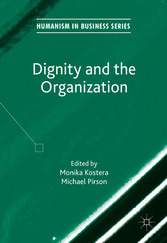Search and Find
Service
Contents
7
Notes on Contributors
9
List of Figures
12
List of Tables
13
1: Introduction to Dignity and Organization
14
References
21
2: Dignity in Organizing from the Perspective of Hannah Arendt’s Worldliness
23
Arendtian Worldliness as Plurality and Durability
25
The Urge to Appear
27
The Dignity of a Durable Human World
29
Culture in a World without Tradition
30
Dignity in Human Activities and Organizing as Conditioning Dignity
32
Organizing as Conditioning Human Freedom
34
Freedom and Equality as Feats of Organization
35
The Dignity of Common Sense
35
Personal Taste and a Longing to Belong
36
The Reality Sense
36
Liquidation of Freedom by Defeating Common Sense and Enacting Laws of Movement
37
Indignation as a “Natural Response” to Breaches of Indignity
39
Dignity in Management and Organization
39
Obedience in Authoritarian Organizations
40
Polis as Organized Remembrance and as Space of Appearance
40
Exploitation of Human Potential for Action as Undignifying or Totalitarian
41
What Does It Mean to Share a Common World?
42
Organizing and Management as Conditioning Dignity
43
Reflective Boundary Management
43
Organizing by Engaging in Sensus Communis on Dignity
45
Arendtian Culture
45
Chapter Summary
46
References
46
Works by Hannah Arendt Are Referred to by Abbreviations
46
3: Dignity and Membership: A Route to the Heart of How Dignity Is Done in Everyday Interaction
49
Introduction
49
Dignity: Transcendent Human Property or Performative Social Outcome?
51
Knowing Dignity: Performativity and Accounts
56
Membership as Method: The Accomplishment and Accounting of Everyday Dignity
59
Doing Dignity: The Benefits and Consequences of a Performative Approach
63
Chapter Summary
65
References
66
4: Dignity and Species Difference Within Organizations
70
Introduction
70
Is It Meaningful to Talk About Animal Dignity?
72
Does ‘Animal Dignity’ Make Sense in the ‘Real World’ of Organizations?
75
Animals in the Making as Actors in Networks
81
Dignity: A Radical Respecification
83
Conclusion
87
Chapter Summary
88
References
88
5: Dignity at the Level of the Firm: Beyond the Stakeholder Approach
92
Introduction: The Role of the Firm under Discussion
92
The Concept of Human Dignity
94
Dignity and the Integrative Social Contracts Theory (ISCT)
97
Human Dignity Inside the Firm: From Theory to Practice
100
Summary of the Chapter
102
References
104
6: Marx, Alienation and the Denial of Dignity of Work
109
Marx and Alienation
110
Marx’s Categories of Alienation
112
Alienation from Product
112
Alienation and the Process of Production
113
Alienation, Dignity and the Division of Labour
114
Alienation and Species-Being
115
Alienated from Others; Undignified Relationships
116
Alienation, Dignity Denial and Private Property
119
Strength of Marx’s View of Alienation
119
Using Marx’s Theory of Alienation to Research Dignity at Work
120
Characteristics of the ICT Industry
121
ICT Professionals and the Work Process
122
Control of the Work Process
122
Allocation of Work
123
The Changing Nature of IT Contracts
123
Awarding Contracts: The Impact on Employment
124
Being Transferred to a New Employer
125
The “Bench”
126
The Impact of the Bench
127
ICT Professionals and the Denial of Dignity
127
Resisting Alienated and Undignified Labour
130
References
132
7: Dignity Restoration: The Indirect Goal of Social Enterprises’ Activity
135
Introduction
135
Social Enterprises: Tools in the Hands of Social Entrepreneurs to Catalyse Positive Social Change
136
The Southeast Credit Union: The Social Enterprise Reviving Human Dignity
141
The Southeast Credit Union (SCU)
141
First Principle: Offering Financial Help
142
Second Principle: Teaching Money Management
146
Third Principle: Giving Experience and Building Confidence
149
Discussion: Dignity Restoration Behind the Actions of Social Enterprises
151
References
155
8: ‘Dignity and Leadership: Implications of Leaders’ Language and Their Assumptions of Human Nature
159
Introduction
159
Dignity and Leadership: An Under-Explored Link
160
Dignity and Leadership
161
Leaders’ Respect Dignity through Culture and Language
166
Studies of Leaders’ Language in the Workplace
169
Conclusion
173
Chapter Summary
174
References
175
9: From Human Resource Management to Human Dignity Development: A Dignity Perspective on HRM and the Role of Workplace Democracy
182
Introduction
182
Human Dignity in the Workplace
184
Underpinnings of Human Dignity
185
Implications of Human Dignity for Organizations and (Strategic) HRM
186
Democracy in the Workplace
188
Foundation of Workplace Democracy
189
Workplace Democracies and Human Dignity
189
Human Dignity, Workplace Democracy and the Employee Life Cycle
191
Branding and Resourcing
192
Performance and Reward Management
194
Talent Management, Learning and Development
196
Employment Relations
197
Exit Management
198
Conclusion
200
References
201
10: Office Design and Dignity at Work in the Knowledge Economy
205
Offices and Work Spaces in the Knowledge Economy
207
Features of the Physical Work Environment and Their Effects on Employees
214
Physical Space, Power, and Dignity: The Road Ahead
220
Chapter Summary
223
References
224
11: Dignity by Design: A Shift from Formalistic to Humanistic Design in Organizations
229
Introduction
230
Formalistic Design
232
From Formalistic to Evidence Based Design in the Healthcare Sector
233
Setting the Stage for Humanistic Design in the Healthcare Industry
235
Transition to Humanistic Design
239
Moving Towards Humanistic Design in Other Sectors
241
Conclusion
245
References
246
12: Concluding Observations
253
Index
256
All prices incl. VAT













